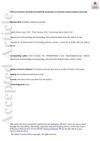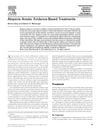TLDR Alopecia areata causes unpredictable hair loss and is hard to treat.
Alopecia areata was characterized by asymptomatic, nonscarring hair loss with spontaneous remissions and exacerbations. Its etiology was unknown, but it was associated with conditions like vitiligo, atopy, pernicious anemia, Down syndrome, and thyroiditis. The hair loss could be localized or affect the entire scalp or body. Treatment was challenging due to individual variability, spontaneous remissions, and high relapse rates. Intralesional corticosteroid injections were the most common treatment, though systemic steroids, contact allergens, minoxidil, psoralens with ultraviolet light, and other agents were also used.
 1 citations
,
October 2020 in “Journal of Cosmetic Dermatology”
1 citations
,
October 2020 in “Journal of Cosmetic Dermatology” Using minoxidil and tofacitinib together can effectively treat severe hair loss.
 9 citations
,
May 2019 in “Journal of dermatological treatment”
9 citations
,
May 2019 in “Journal of dermatological treatment” Apremilast helps regrow hair in hard-to-treat alopecia areata.
September 2014 in “DOAJ (DOAJ: Directory of Open Access Journals)” Rosemary is as effective as Minoxidil for treating alopecia areata.
 109 citations
,
May 2011 in “Dermatologic Therapy”
109 citations
,
May 2011 in “Dermatologic Therapy” Alopecia areata is a type of hair loss that can lead to complete baldness, often associated with other autoimmune conditions, and half of the cases may see hair return within a year.
 71 citations
,
March 2009 in “Seminars in cutaneous medicine and surgery”
71 citations
,
March 2009 in “Seminars in cutaneous medicine and surgery” Alopecia areata can cause unpredictable hair loss, and treatments like corticosteroids and minoxidil may help but have varying side effects.



